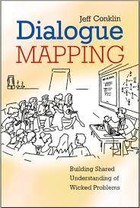What Are Wicked Problems, Why Are They Wicked, and How Do You Deal with Them?
 I’ve been thinking a lot about wicked problems recently.
I’ve been thinking a lot about wicked problems recently.
As faithful readers know, I’ve been embroiled for the past 10 months in a local community hospital issue and have aired our progress (or lack thereof) in a series of posts.
Our recent consulting work has also exposed us to a number of wicked problems: one is the design of a transformational new product line for a highly conservative industry in which our client is both a new incumbent and a distant also ran; the other involves trying to help a well-meaning group of very smart people get rid of layers of barnacles and bureaucracy so they can do their almost impossible jobs. Blowing up and starting over is not currently an option, at least not without dealing with the evolution of the current state at the same time.
I love these kinds of challenges! But they are frustrating and intractable. What makes them so is that they involve “wicked problems.” Wicked problems aren’t just hard problems to solve. They are design dilemmas that are heavily embedded in social context for which there is no solution. There are only approaches that are somewhat better for some, but not all, of the stakeholders. But what makes wicked problems particularly wicked is that it’s really hard to wrap your collective minds around them. And it’s difficult to do so without people taking sides or putting forward their own agendas. We are human, after all. We are social animals. We have agendas and careers and values and experience and history and things we are passionate about.
So, I found it refreshing to take some time out from this brain-breaking work to read a book written by an old acquaintance and colleague with whom I’d recently reconnected (through the auspices of Linked In!). The book is Dialogue Mapping: Building Shared Understanding of Wicked Problems.
 Jeff Conklin has spent his entire career helping organizations and groups of people deal with wicked problems by 1) focusing on them as his sweet spot, and b) developing tools and methods to help groups of people develop shared understanding. Here’s Jeff’s take both on why wicked problems are so wicked and why shared understanding helps.
Jeff Conklin has spent his entire career helping organizations and groups of people deal with wicked problems by 1) focusing on them as his sweet spot, and b) developing tools and methods to help groups of people develop shared understanding. Here’s Jeff’s take both on why wicked problems are so wicked and why shared understanding helps.
“It turns out there's a slippery linguistic trap in the name 'wicked problem,' because the name implies there's a 'solution.’ It's more accurate to talk about the degree of 'wickedness' in a situation (or perhaps how messy a given 'mess' is). (Framing the challenge in this way might help to break our addiction to racing around creating and exacerbating 'problems' with our 'solutions'.) The truth is that a wicked problem is a set of interlocking issues across many domains (i.e., political, environmental, economic, etc.), and any attempt to bound the scope of the challenge is arbitrary. Moreover, only a tame problem can be 'solved' -- wicked problems can only be managed more or less effectively, more or less efficiently. The best we can do is to find more elegant and expedient interventions, but ultimately the human condition is that there's no getting away from the 'Whac-a-mole' phenomenon that even the most elegant intervention on a wicked problem will make some issue(s) more wicked for some stakeholder(s).”
Even getting started on coming up with a solution to a wicked problem is intractable. Everybody involved has a different definition of “the problem,” and all of those definitions are probably flawed because we (collectively) don’t yet know enough. Jeff Conklin explains:
“With social complexity, ‘not understanding the problem’ does not show up as innocent wonder about the mystery of the problem, neither does it usually occur as a thoughtful collective inquiry into the deeper nature of the problem. Rather, ‘not understanding the problem’ shows up as different stakeholders who are certain that their version of the problem is correct or at least that other versions are fatally flawed. In severe cases, such as many political situations, each stakeholder’s position about what the problem is reflects the mission and objectives of the organization (or country) they represent.”
“The Holy Grail of effective collaboration – is in creating shared understanding about the problem, and shared commitment to the possible solutions. Shared understanding does not mean we necessarily agree on the problem, although that is a good thing when it happens. Shared understanding means that the stakeholders understand each other’s positions well enough to have intelligent dialogue about the different interpretations of the problem, and to exercise collective intelligence about how to solve it. Because of social complexity, solving a wicked problem is fundamentally a social process.”
~ Jeff Conklin
Here are some of my take-aways from reading Jeff ’s seminal book:
How to Address “Wicked Problems”
Use Dialogue Mapping to Build a Shared Understanding and Evolve a Group’s Thinking
By Patricia B. Seybold, CEO & Sr. Consultant, Patricia Seybold Group, May 23, 2013
0 comments
Be the first one to comment.


